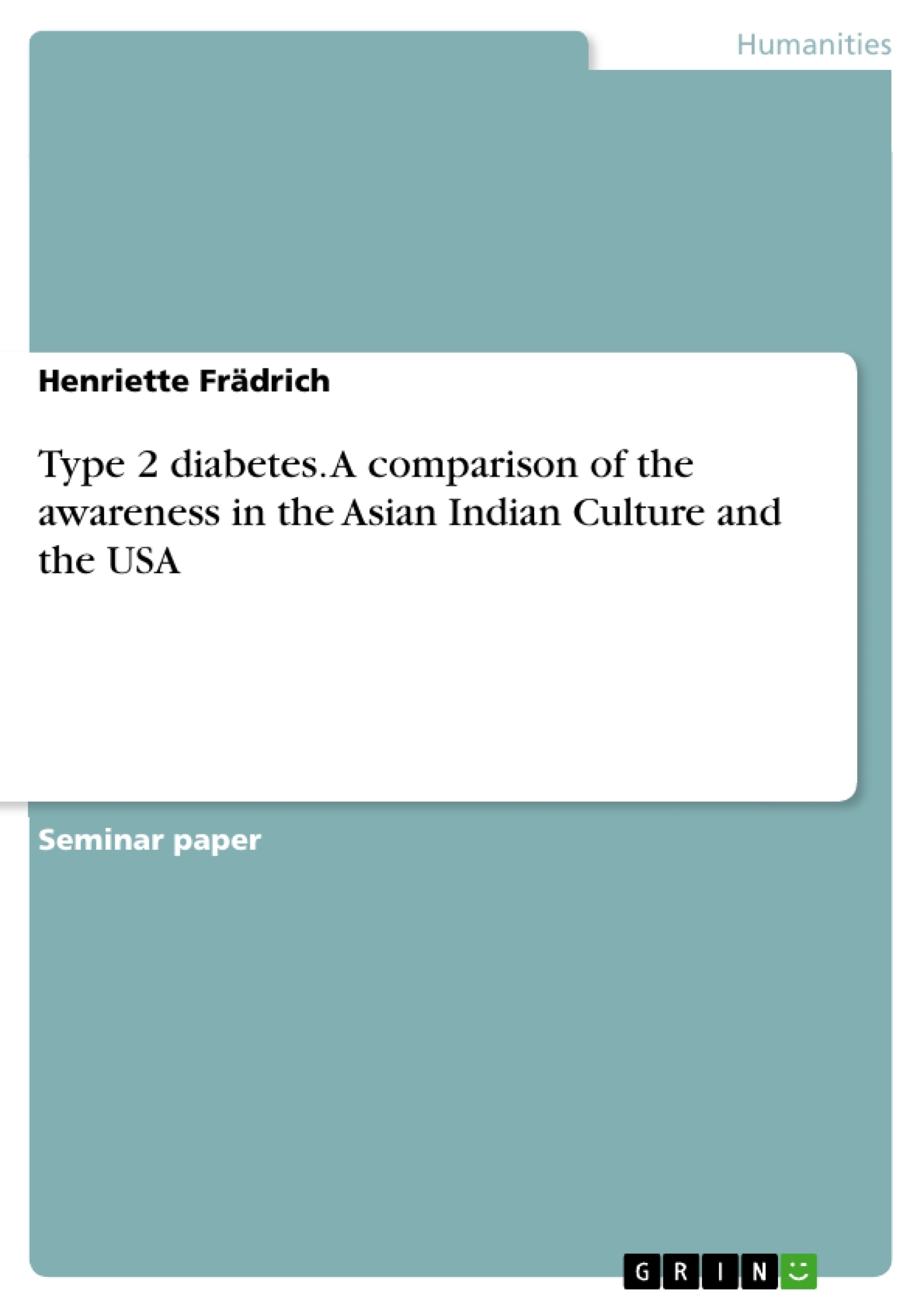For some time now India has been undergoing a nutrition transition which boosts the development of overweight and obesity leading to chronic diseases such as type 2 diabetes. Due to industrialisation and modernization, the diet of Indians living in urbanised areas changes from traditional diets to excessive intake of western fast food. Besides these dietary factors the rising lack of physical activity is highly associated with the rising emergence of the aforementioned disease.
According to the Asian Diabetes Prevention Initiative, in the year 2013 60% of diabetics lived in Asia, whereby India was home to the second largest population of individuals with type 2 diabetes worldwide, with 65.1 million diabetics. In contrast,
the American Diabetes Association reported 21.9 million diabetics for the year 2012. As a result, the awareness of influencing factors for the development respectively prevention of type 2 diabetes should be quite high for both countries, and even higher for the Asian Indian population. To see if this is the case, in this paper I am going to examine the English language of both cultures with the help of corpus-linguistic analysis.
Some factors influencing the emergence of type 2 diabetes were already mentioned before. Overweight and obesity are clearly the main risk factors for developing type 2 diabetes.
Asian Indians have a higher percentage of abdominal body fat compared to Europeans, which leads to a higher insulin resistance associated with type 2 diabetes. Therefore, Asian Indians have a higher prevalence for developing type 2 diabetes than other ethnic groups, even at a lower Body Mass Index. Of course, body weight is highly dependent on nutritional factors. In addition to the traditional consumption of already unhealthy white rice, refined grains and saturated fats from palm oil, especially the increased consumption of western fast food raises the intake of fat, sugar and calories.
Inhaltsverzeichnis (Table of Contents)
- Theoretical and cultural Background
- Main risk factors for developing Type 2 Diabetes
- Awareness of influencing factors for developing and preventing Type 2 Diabetes
- Awareness and use of alternative medicine for treating Diabetes
- Leading question and presumptions
- Method and corpus
- Approach and results
- Frequency of Type 2 Diabetes in Indian English and U.S. English
- Frequency of overweight and obesity
- Type 2 Diabetes and its correlation with overweight and obesity
- Awareness of different forms of treatment for Type 2 Diabetes
- Summary and discussion
- References
Zielsetzung und Themenschwerpunkte (Objectives and Key Themes)
This paper aims to examine the awareness of type 2 diabetes and its influencing factors in Indian and U.S. American cultures through a corpus-linguistic analysis of both English varieties. The main objective is to compare the awareness levels of these cultures, particularly focusing on the role of alternative medicine in India.- Cultural influence on health perceptions
- Awareness of risk factors for developing type 2 diabetes
- Prevalence and understanding of alternative treatments for diabetes
- Linguistic representation of cultural beliefs and attitudes
- Comparison of Indian English and U.S. English usage patterns
Zusammenfassung der Kapitel (Chapter Summaries)
- Theoretical and cultural Background: This chapter discusses the rising prevalence of type 2 diabetes in India, linking it to factors such as nutrition transition, westernized diets, and lack of physical activity. It highlights the high prevalence of diabetes in India compared to the USA, setting the stage for the analysis of cultural awareness.
- Main risk factors for developing Type 2 Diabetes: This section focuses on overweight and obesity as primary risk factors for developing type 2 diabetes, highlighting the higher prevalence of abdominal body fat among Asian Indians and their susceptibility to insulin resistance. It also emphasizes the role of dietary factors and lack of physical activity in promoting these risks.
- Awareness of influencing factors for developing and preventing Type 2 Diabetes: This chapter explores the awareness of influencing factors among Asian Indians, citing research that indicates a generally low level of awareness regarding causes, symptoms, complications, and preventive measures like physical activity and healthy diets.
- Awareness and use of alternative medicine for treating Diabetes: This section delves into the awareness and use of alternative treatments for type 2 diabetes, particularly focusing on the prevalence of Ayurvedic medicine in India. It highlights research suggesting a higher awareness and use of alternative medicine among Indian diabetics compared to their U.S. counterparts.
- Leading question and presumptions: This chapter introduces the central question of the paper: how do cultural beliefs influence language and, consequently, awareness of type 2 diabetes in India and the USA? It sets forth the assumptions that Asian Indians may have a higher awareness of the causes of type 2 diabetes due to their genetic predisposition and a greater awareness of alternative treatments due to their Ayurvedic heritage.
- Method and corpus: This section outlines the research methodology, which involves using the GloWbE corpus to analyze Indian English and U.S. English for linguistic patterns related to type 2 diabetes. The GloWbE corpus and its features are described, providing context for the subsequent analysis.
- Approach and results: This chapter presents the initial findings of the analysis, focusing on the frequency of terms like "type 2 diabetes" and "overweight/obesity" in both English varieties. It explores the correlation between these terms, providing insights into the awareness of the link between obesity and diabetes in the two cultures.
Schlüsselwörter (Keywords)
The key themes and concepts explored in this paper revolve around type 2 diabetes, cultural awareness, alternative medicine, corpus linguistics, Indian English, U.S. English, nutrition transition, overweight, obesity, and Ayurvedic medicine. These keywords encompass the core research focus, important themes, and key concepts examined within the context of the paper.- Quote paper
- Henriette Frädrich (Author), 2015, Type 2 diabetes. A comparison of the awareness in the Asian Indian Culture and the USA, Munich, GRIN Verlag, https://www.grin.com/document/337302



